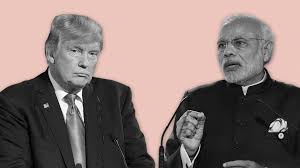Prime Minister Narendra Modi’s upcoming visit to Washington on February 13 marks a crucial moment in U.S.-India relations, as both nations navigate challenges related to trade, defense, and immigration policies. This visit, an “official working visit,” makes Modi the fourth foreign leader to be hosted by President Donald Trump since his return to the White House on January 20, 2025. Notably, it is the earliest visit by an Indian Prime Minister to any newly elected U.S. President in recent history.
Modi’s February 12-13 visit comes as Trump enters the fourth week of his second presidency, during which his focus has been on domestic priorities, a controversial Middle East peace plan, and tariff impositions affecting global trade, including India.
Modi’s visit is expected to be constructive, with discussions likely to reinforce strategic partnerships in defense and trade while addressing key irritants such as tariffs and immigration.
One of India’s top priorities in this meeting is ensuring the humane treatment of Indian deportees. Recently, the U.S. deported a batch of 104 undocumented Indian immigrants, with another 800 individuals expected to be deported soon. India has expressed concerns over the treatment of its citizens and is seeking U.S. assurances on due process and humane conditions.
Currently, 725,000 Indian immigrants reside in the U.S., of whom about 20,000 are identified for deportation. Modi is expected to push for clarity on legal immigration pathways, ensuring that Indians continue to have access to U.S. work visas, study permits, and tourism opportunities.
Trade has been a contentious issue between India and the U.S., with Trump frequently criticizing India’s tariff policies, labeling it a “tariff king”. The U.S. has imposed 25% tariffs on steel and aluminum imports, without exemptions for allies, raising concerns among Indian manufacturers who rely on access to American markets.
India has taken preemptive steps to ease tensions, including reducing tariffs on high-end motorcycles and electric batteries. Modi’s visit presents an opportunity to negotiate a balanced trade agreement that would allow for greater U.S. market access while ensuring fair terms for Indian exports.
India is also expected to discuss increasing energy imports from the U.S., particularly liquefied natural gas (LNG), and lowering duties on select American agricultural products—a move that could benefit Republican-dominated states that produce bourbon, pecans, and other goods.
Defense spending will be a key component of Modi’s visit, as India continues to expand military ties with the U.S. Over the past few years, India has made significant purchases of American military equipment, including fighter jets, drones, and missile systems. The visit may include announcements of new defense agreements, reinforcing India’s role as a key security partner in the Indo-Pacific region.
India occupies a unique position in global geopolitics, neither being a traditional U.S. ally like the UK or Japan nor an economic rival like China. While China faces heavy scrutiny in Washington, India has often benefited from U.S. policymakers adopting a more cooperative approach.
Some key figures in Trump’s administration, including National Security Advisor Mike Waltz—who previously led the India Caucus in Congress—have shown strong support for enhancing U.S.-India defense collaboration. Similarly, Senator Marco Rubio has advocated for closer economic and strategic ties between the two nations.
PM Modi’s visit to the U.S. at this early stage of Trump’s second term signals a strong commitment to strengthening bilateral ties. While contentious issues like trade disputes, tariffs, and immigration policies remain, the meeting provides an opportunity for both leaders to reinforce their shared economic and security goals.
As India and the U.S. continue to navigate their evolving relationship, this visit is not just about resolving immediate challenges—it is about laying the foundation for long-term strategic cooperation in a rapidly changing global order.

